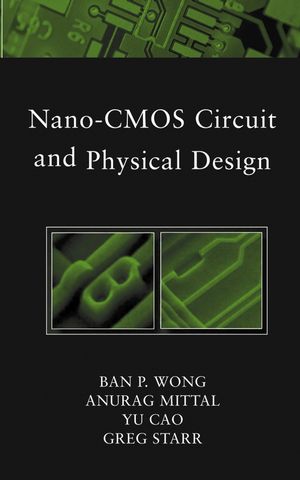Nano-CMOS Circuit and Physical DesignISBN: 978-0-471-46610-9
393 pages
December 2004, Wiley-IEEE Press
|
Description
Table of Contents
PREFACE.
1 NANO-CMOS SCALING PROBLEMS AND IMPLICATIONS.
1.1 Design Methodology in the Nano-CMOS Era.
1.2 Innovations Needed to Continue Performance Scaling.
1.3 Overview of Sub-100-nm Scaling Challenges and Subwavelength Optical Lithography.
1.4 Process Control and Reliability.
1.5 Lithographic Issues and Mask Data Explosion.
1.6 New Breed of Circuit and Physical Design Engineers.
1.7 Modeling Challenges.
1.8 Need for Design Methodology Changes.
1.9 Summary.
References.
PART I: PROCESS TECHNOLOGY AND SUBWAVELENGTH OPTICAL LITHOGRAPHY: PHYSICS, THEORY OF OPERATION, ISSUES, AND SOLUTIONS.
2 CMOS DEVICE AND PROCESS TECHNOLOGY.
2.1 Equipment Requirements for Front-End Processing.
2.2 Front-End-Device Problems in CMOS Scaling.
2.3 Back-End-of-Line Technology.
References.
3 THEORY AND PRACTICALITIES OF SUBWAVELENGTH OPTICAL LITHOGRAPHY.
3.1 Introduction and Simple Imaging Theory.
3.2 Challenges for the 100-nm Node.
3.3 Resolution Enhancement Techniques: Physics.
3.4 Physical Design Style Impact on RET and OPC Complexity.
3.5 The Road Ahead: Future Lithographic Technologies.
References.
PART II: PROCESS SCALING IMPACT ON DESIGN 4 MIXED-SIGNAL CIRCUIT DESIGN.
4.1 Introduction.
4.2 Design Considerations.
4.3 Device Modeling.
4.4 Passive Components.
4.5 Design Methodology.
4.6 Low-Voltage Techniques.
4.7 Design Procedures.
4.8 Electrostatic Discharge Protection.
4.9 Noise Isolation.
4.10 Decoupling.
4.11 Power Busing.
4.12 Integration Problems.
4.13 Summary.
References.
5 ELECTROSTATIC DISCHARGE PROTECTION DESIGN.
5.1 Introduction.
5.2 ESD Standards and Models.
5.3 ESD Protection Design.
5.4 Low-C ESD Protection Design for High-Speed I/O.
5.5 ESD Protection Design for Mixed-Voltage I/O.
5.6 SCR Devices for ESD Protection.
5.7 Summary.
References.
6 INPUT/OUTPUT DESIGN.
6.1 Introduction.
6.2 I/O Standards.
6.3 Signal Transfer.
6.4 ESD Protection.
6.5 I/O Switching Noise.
6.6 Termination.
6.7 Impedance Matching.
6.8 Preemphasis.
6.9 Equalization.
6.10 Conclusion.
References.
7 DRAM.
7.1 Introduction.
7.2 DRAM Basics.
7.3 Scaling the Capacitor.
7.4 Scaling the Array Transistor.
7.5 Scaling the Sense Amplifier.
7.6 Summary.
References.
8 SIGNAL INTEGRITY PROBLEMS IN ON-CHIP INTERCONNECTS.
8.1 Introduction.
8.2 Interconnect Parasitics Extraction.
8.3 Signal Integrity Analysis.
8.4 Design Solutions for Signal Integrity.
8.5 Summary.
References.
9 ULTRALOW POWER CIRCUIT DESIGN.
9.1 Introduction.
9.2 Design-Time Low-Power Techniques.
9.3 Run-Time Low-Power Techniques.
9.4 Technology Innovations for Low-Power Design.
9.5 Perspectives for Future Ultralow-Power Design.
References.
PART III: IMPACT OF PHYSICAL DESIGN ON MANUFACTURING/YIELD AND PERFORMANCE.
10 DESIGN FOR MANUFACTURABILITY.
10.1 Introduction.
10.2 Comparison of Optimal and Suboptimal Layouts.
10.3 Global Route DFM.
10.4 Analog DFM.
10.5 Some Rules of Thumb.
10.6 Summary.
References.
11 DESIGN FOR VARIABILITY.
11.1 Impact of Variations on Future Design.
11.2 Strategies to Mitigate Impact Due to Variations.
11.3 Corner Modeling Methodology for Nano-CMOS Processes.
11.4 New Features of the BSIM4 Model.
11.5 Summary.
References.
INDEX.
Author Information
ANURAG MITTAL received his PhD in applied physics from Yale University. He has codeveloped novel embedded NVM microcontroller and microprocessor solutions including the world’s first truly CMOS-compatible Flash technology. He is Senior Staff Engineer for Virage Logic, Inc.
YU CAO received his PhD in electrical engineering from University of California, Berkeley. He is a postdoctoral researcher in the Berkeley Wireless Research Center. He received the 2000 Beatrice Winner Award at the IEEE International Solid-State Circuits Conference.
GREG STARR received his PhD in electrical engineering from Arizona State University. Currently, he is a Senior Design Manager at Xilinx Corporation.



